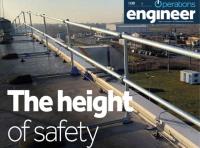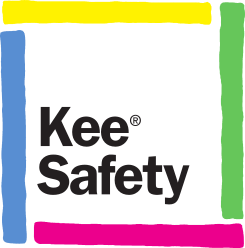 Add My Company
Add My Company
Sign In

Products and standards that reduce the risks of fatal falls from height
Reducing the risk of fatal falls
Falls from height remain, statistically, amongst the largest cause of occupational fatalities within the workplace. According to the Health and Safety Executive (HSE) in 2018-19, in the last five years falls from height have accounted for 26% of all fatal accident injuries (an average of 37 fatal injuries per year). 60% of deaths when working at height involve falls from ladders, scaffolds, working platforms and roof edges, and through fragile roofs.
An important way to reduce these fatalities is to ensure that safety systems like those produced by Kee Safety, that are used to protect against falls from height, are inspected properly, are in perfect working condition and are recorded properly.
Safety systems for protecting people working at height
here are many safety systems that are designed to protect people working at height. These include:
roof guardrails,
level, anti-slip rooftop walkways (which not only protect the workers, but the roof itself from the load applied by them, these can also feature handrails),
platforms and walkways,
skylight fall protection systems,
safety gates,
lifeline and anchor fall arrest/restraint systems (that attach a worker to a wall or rooftop to stop them from falling if they slip).
Counterweighted guardrail systems
Counterweighted Guardrail Systems were used where workers carried out flat roof refurbishments/repairs at heights as defined by the Work at Height Regulations 2005. They feature a lifting base foot at the bottom of each vertical part of the guardrail which are individually fitted with a cantilever tube/counterweight to secure them in place. These products did not penetrate the roof membrane and it soon became apparent they could be used as a Permanent Counterweighted Guardrail System (PCGS), but there wasn’t a specific standard for such products.
Permanent counterweighted guardrail system
In a continuous drive to improve Occupational Safety and Health within the work at height industry the British Standards Institution (BSI) develops the standards that improve the safety and quality of products, services and systems such as these.
Anne Hayes, director of sector standards at BSI, says: “BSI publishes over 2,700 standards annually, underpinned by a collaborative and consensus-based approach.
Committees are made-up of stakeholders who fairly represent the range of interests affected by the standard, they include industry experts, government bodies, trade associations, businesses of all sizes and consumers. The committee comes together to develop the consensus standards that reflects best practice.”
The standard BS 13700, released in Spring 2021, constitutes what Kee Safety says, is a long overdue specific standard for PCGS.
New standard for PCGS
BS 13700 brings clarity and consistency for the manufacturer, designer, duty holder (owner of the organisation) and recertification technician (the inspector), ensuring these safety critical edge protection systems are designed, installed, inspected, and maintained to the highest standard.
Two of the most important features of the new standard include:
Requiring all guardrail installations to be designed for specific wind speed calculation in relation to the location, height of building and exposure level. All manufacturers will have to provide calculations or software programs to comply with this requirement.
Introduction of the requirement for annual recertification of counter balanced guardrails installed permanently and requires a thorough examination scheme to be documented as part of the Technical File for the project.
Specific wind speed calculation
Graham Willmott, group risk management and standards director at Kee Safety, says: “Wind speed is far more onerous then a person falling against the guardrail and, in fact, likely to be more frequent.”
He adds that because wind speeds in the South of the UK are lower than those experienced in the North, PCGSs must include design flexibility to accommodate local wind speeds. For instance, additional counterweights can be added, longer cantilever tubes may be required, bay centres (distance between vertical supports) may have to be reduced and so on.
PCGS System Technical File
Following the ‘best practice’ requirements of BS 7883:2019 every installation should have a ‘System Technical File’. This evidence-based document is produced by the System Designer who passes it on to the duty holder and should be placed as part of the health and safety file required under the Construction (Design and Management) Regulations 2015.
The duty holder must then retain the file and ensure it is available to anyone who may need it for as long as it is relevant – normally the lifetime of the building – to enable them to comply with health and safety requirements during any subsequent work/inspection. The System Technical File should include the system design and layout, design calculations, and wind speed calculations permitting compatibility, safety, and operational suitability to be assessed and verified.
Should any of this information be absent at the time of an inspection, companies like Kee Safety can assist duty holders with completing a full system review of their fall protection system and, where applicable, undertaking supplementary inspections to establish how the product was structurally anchored into the base material.
Willmott adds: “Our system provides the duty holder and recertification technician with clarity and consistency of approach and interpretation of the specific product standards and their complexities.
Duty holders receive a full inspection visit report, including a summary of their building’s fall protection equipment condition. Reports are submitted in an electronic format and for multiple site inspections these can be hosted on our online portal, allowing access to all building/site reports in one safe place.”
Personal fall protection safety systems
Alternative personal fall protection safety systems must also be installed and maintained in order to reduce fatalities; such systems include
eyebolts,
horizontal life lines.
The latest revision of BS 7883, released in November 2019, constitutes a revised, and comprehensive best practice Standard for those designing, installing, maintaining, inspecting and certifying anchor devices and systems.
nspection of personal fall protection systems
Those inspecting such systems must be aware of what components should be utilised, are in place, and if they are potentially missing, installed incorrectly or assembled with incompatible components.
Wilmott says: “We have invested in the latest field-based technology which is fully aligned with the new standards requirements and the appropriate examination scheme of a building’s fall protection equipment and supplementary requirements.”
Personal fall protection system technical file
The latest guidance recommends that a record of all hidden elements and the materials obscuring them is detailed within the System Technical File, including evidential and sequential photographs taken during installation. Many original installations may not have this critical verification documentation, and a full system review and supplementary engineering inspection revealing the hidden elements may be required.
More effective legislation and greater awareness
Hayes adds: “All British Standards are subject to review at least every five years. BSI ensures that technical committees take responsibility for each British Standard and undertake such reviews and consider any matters of concern brought to its notice at any other time.”
Wilmott highlights a downwards trend in the statistics for fatalities at work as well as those resulting from falls from height. He attributes this to more effective legislation and standards as well as greater awareness, especially as a successful prosecution is no longer reliant on an accident occurring, but the actual risk of harm potentially occurring.
For more information on Products and standards that reduce the risks of fatal falls from height talk to Kee Safety
Enquire Now
List your company on FindTheNeedle.

